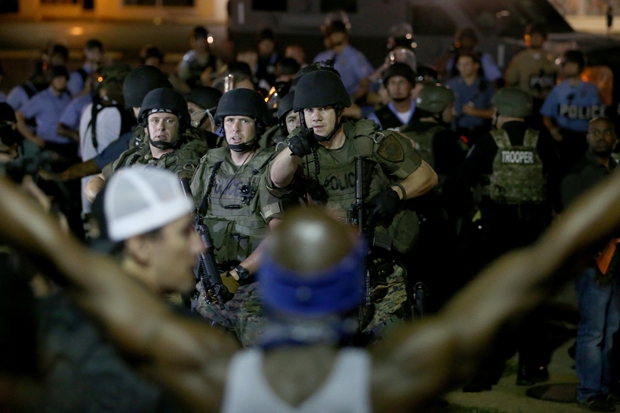The ongoing Ferguson crisis in America is really two stories rather than one. The first story is the straightforward mystery of what happened when Darren Wilson (‘the white cop’) killed Michael Brown (‘the black youth’). The second story, much loved by the British and American media, is ‘America’s Racial Divide’.
The two stories are related, of course, but not in quite the way that links them in most reporting and commentary. The first story is treated as another episode in the second’s larger ‘narrative’, which is that white America is murderously hostile to its black minority. Few people express this view as openly as the film-maker Spike Lee, who declared simply that ‘there is a war on the black male’. But his argument has been the leitmotif of media discussions from the moment it became known that a white cop had killed a black man.

Exactly the same narrative shaped coverage of Trayvon Martin’s death in Florida last year to the point that the New York Times described his alleged murderer, George Zimmerman, as ‘a white Hispanic’ so that no one would be confused about the racial significance of the case. NBC News similarly edited a police tape of Zimmerman so that it seemed he had spontaneously remarked that Martin was black (he was in fact responding to a question from the police about Martin’s race). Zimmerman was acquitted nonetheless, and many of those who had followed the evidence in court judged the verdict correct (even if he might well have been convicted of a lesser offence). But the acquittal was received with indignant demands from politicians, lawyers, journalists and organisations such as the NAACP for the Justice Department to launch a civil rights prosecution against him.
There are in fact competing narratives in such cases: ‘white cop shoots unarmed black’ versus ‘liberal establishment railroads unlucky cop’. Which narrative triumphs should be decided in principle by particular evidence of specific acts in a court of law. That evidence against Darren Wilson in the killing of Michael Brown looks strong. But that was also true initially of the Zimmerman–Martin trial. We have yet to hear the case for Wilson. And some of the stories leaking out — Brown’s previous assaults, his being high on marijuana that night — would serve to exculpate Wilson if they prove true.

Today, however, many influential people are less interested in the facts before the court than in whether a verdict strengthens their political or ideological interests. When they demand justice, they want Wilson convicted to confirm that America is waging war on black youth. And vice versa for an acquittal. A real person must be imprisoned (or his death left unpunished) in order to prove a point.
Even so, the divisions over such symbolic cases are not a simple binary black-white distinction. Polls suggest that one fifth of black Americans think the police response to the shooting ‘has been about right’, and about the same number think that race was getting too much attention as a factor. That is not an insignificant percentage. In the current atmosphere, however, some courage and independence of mind are probably required for black people to resist the drive towards simple condemnation of Wilson, the cops and American racism. At the same time those black Americans in Ferguson whose businesses, homes and persons are under threat from rioters and ‘protesters’ likely don’t see themselves as sharing either common interests or common values with their tormentors. A few black clergymen have said exactly that.

A map of racial divisions on these issues might look something like this. There is a broad identity of interest between private-sector middle-class whites, black blue-collar workers and black small-business owners. What they want is stability, economic opportunity, low taxes and protection from crime. A similar coalition on the other side would bring together the white liberal ‘knowledge class’, the black middle class in the public sector, and underclass black people dependent upon government. What they want is a growing public sector, extensive welfare, and a large but weak government. If we confine our gaze to Black America, we see an apparent alliance between the public-sector intelligentsia and the underclass against the small-business and blue-collar classes in order to redistribute their wealth through higher taxes, greater public spending and crime. Cases such as the Michael Brown killing tend to strengthen this alliance and to draw blue-collar workers and small-business people into it by raising racial tensions with white America and dividing the natural allies in the first potential coalition. But when rioting and looting go beyond the symbolic and trash homes and businesses, they push people back into the first coalition and divide the second.
Blaming American racism has proved a successful political strategy but a failed governing one. The war on black Americans has in fact been waged most ruthlessly by liberal Democrats who believed they were defending them. Consider the loss of jobs, the poor quality of ghetto schools, the murder of young black men by cops or by other young black men. (Murder is overwhelmingly an intraracial crime.) All of these ills are most prevalent in cities such as Chicago and Detroit which have been governed by Democrats for half a century. This is not a major theme of media commentary — just as the least mentioned fact about the Ferguson crisis is that Missouri’s hapless Governor Jay Nixon is a Democrat.





Comments